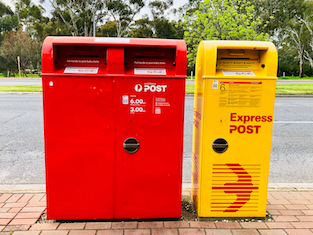Hyphens and compound adjectives

There is a difference between red-hot metal and red hot metal.
We know that we use adjectives to describe nouns, pronouns and other adjectives. But when we have a long string of adjectives before a noun, it is possible that some of them describe another adjective, rather than the noun at the end of the string. Consider these two sentences:
- The blacksmith created a horseshoe from the red-hot metal.
- I posted the chocolates early and was then worried that they would melt as they sat all day in the red hot post-box.

A post-box can be both hot and red: a red, hot post-box.
In the first sentence, red is describing the hotness of the metal: it is red hot, not white hot. The sentence does not mean that the metal is coloured red. But in the second sentence, red is describing the post-box, not the hotness of the post-box. Heat can be described in a number of ways: for example, welding produces a white-hot flame, not a red-hot one. To show that red is describing hot and not metal in the first sentence, we use a hyphen to connect the adjective red to the other adjective (hot) that it is describing. The hyphen creates a multi-word adjective that we call a compound adjective. The fact that the adjectives in the second sentence are not connected means that the both, separately, describe the post-box: it is a red post-box, and it is also a hot post-box. (Note: generally, we would not write ‘red hot post-box’ but ‘hot red post-box’: I have used an incorrect order of adjectives simply to make a point.)

Welding produces a white-hot flame.
We need to take care when creating compound adjectives, because the placement of the hyphens can change the meaning. Consider this sentence:
- The lane is blocked by a gate and a two metre high security fence.
We have four adjectives before the word fence, and without extra help we cannot tell exactly what the writer means (which of the adjectives describe each other, and which describe the fence). The sentence could be either of these:
- The lane is blocked by a gate and a two-metre high-security fence.
- The lane is blocked by a gate and a two-metre-high security fence.
There are two ways to work out what the sentence should be: does two-metre describe high or fence, or does high describe security? Do we have a fence that provides high security, and is also two metres wide? Or do we have a fence that is two metres high, but possibly not very secure?

A two-metre high-security fence? Or a two-metre-high security fence (which maybe isn’t so secure)?
Predicative adjectives
I explained in an earlier post that adjectives can also be placed at the end of a sentence, after both the noun they describe and also after a verb. When adjectives are in this final position they are known as predicative adjectives (while those immediately before a noun are attributive adjectives).
- Much of Melbourne’s architecture is nineteenth century.
- The nineteenth-century library, with its recently restored Reading Room, is one example.
In the first sentence, the predicative adjective nineteenth describes century, and together nineteenth and century describe architecture, but we do not add a hyphen and form a compound adjective. The reason is that there is no other word (or noun) that nineteenth can describe in this sentence. The only word it can describe is century. We do not need to hyphenate the two words because there is no confusion about what word nineteenth describes (compare the red-hot metal example we looked at earlier). In the next sentence, where nineteenth and century are attributive adjectives, we do form a compound adjective with a hyphen to show that nineteenth describes century, not library (we are not talking about the nineteenth library here, although in another sentence we could be).

The nineteenth-century Reading Room of the State Library of Victoria
The general rule is that we don’t make hyphenated compound adjectives when the adjectives come at the end of the sentence; we don’t make hyphenated compound predicative adjectives. (See how each of those four adjectives describes the final noun, adjectives!) We use hyphenated multi-word (or compound) adjectives before a noun, or from attributive adjectives, and we do this to make it clear what words are describing other words: whether an adjective is describing another adjective or the final noun. It can seem confusing that compound adjectives (like nineteenth century) are sometimes hyphenated and sometimes not, but the purpose of the hyphen is simply to solve confusion when the adjective could apply to more than one word. It is simply there to solve confusion, not create it. With a little practice, and careful checking of which words are describing which other ones, knowing when to hyphenate compound adjectives and when not to does become almost second nature. (I have written more about when to use hyphens.)

If you have found this post interesting, you can find a full index to my other posts on the index page. To be notified when I post a new topic, follow me on Facebook! If you have any particular questions you’d like me to answer in future posts, just send me a message. I’m always interested to learn what people think, and how you came across this site, so please post a comment.
If you think you would be interested in either my complete grammar course or an individual customised online course (particularly suited for people who don’t live in Melbourne), just click your preferred option.
Photos: blacksmith and horseshoe by Jonathan Bean on Unsplash; post-box by Shutterstock.com; welding by Christopher Burns, gate and fence by Osman Rana, fence with hole by Calvin Ma, Reading Room by Finn Whelen, all on Unsplash